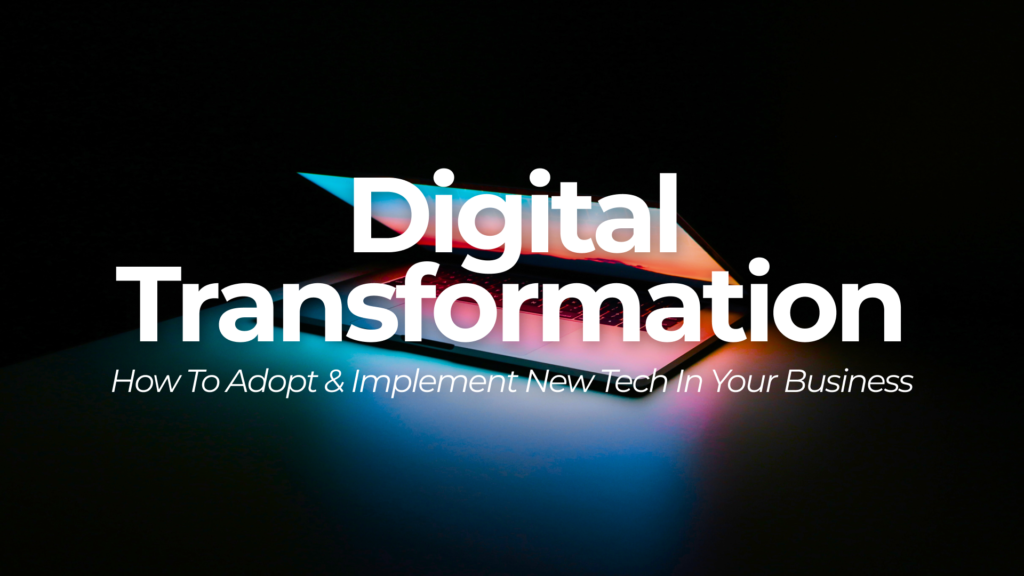Digital transformation refers to the integration of digital technologies into all aspects of a business, resulting in fundamental changes to how they operate and deliver to its customers. In today’s fast-paced and ever-changing business landscape, digital transformation has become a necessity for businesses of all sizes and industries to keep up with their competition. In fact, according to a study by McKinsey, companies that have embraced digital transformation become 26% more profitable than their industry peers.
However, a successful digital transformation requires careful planning and execution to ensure that it aligns with your business objectives and delivers measurable results. Digital transformation isn’t just about adopting new technologies; it’s also about changing the way a business operates, from its organisational structure to its culture. It involves identifying areas for improvement, choosing the right technologies, and managing change effectively.
In this blog, we’ll provide insights and practical tips on how to adopt and implement new technologies in your business. We will also discuss best practices for digital transformation and provide case studies of successful implementations. So, whether you’re a small business owner or a CEO of a large enterprise, this blog will provide valuable information to help you navigate the complex world of
digital transformation. Let’s take a look…
Benefits of Digital Transformation
Digital transformation is more than just a buzzword; it offers businesses numerous benefits that can help them stay competitive and succeed in today’s fast-paced business landscape. According to a survey by IDG, 89% of organisations have already adopted a digital-first business strategy, indicating the importance of digital transformation in the modern business environment.
One of the most significant benefits of digital transformation is increased productivity and efficiency. By automating manual processes, businesses can streamline operations and reduce the risk of errors. This not only saves time but also reduces costs, allowing businesses to focus on higher-value tasks.
Digital transformation can also lead to improved customer experiences. By leveraging data and analytics, businesses can gain insights into customer behaviour and preferences, enabling them to personalise offerings and tailor interactions to individual customers. This can lead to increased customer satisfaction, loyalty, and retention, which ultimately drives revenue growth.
Another benefit of digital transformation is the competitive advantage. By adopting new technologies, businesses can gain a competitive edge over their peers. For instance, businesses that embrace artificial intelligence and machine learning can analyse data faster and more accurately than those that don’t, enabling them to make better informed decisions quicker.
Finally, digital transformation can provide access to new markets and customers. By leveraging digital technologies, businesses can expand their reach and tap into new markets that were previously inaccessible. This can lead to increased revenue and growth opportunities.
Identifying Areas for Digital Transformation
Before embarking on a digital transformation journey, it is essential to identify areas for improvement and prioritise them based on their impact on the business. According to a survey by Accenture, 63% of companies say that “identifying the right digital priorities” is the biggest challenge of their digital transformation initiatives.
To identify areas for digital transformation, businesses need to conduct a digital assessment, which involves evaluating the current state of their technology infrastructure, processes, and organisational structure. This assessment can reveal areas that require improvement and help businesses prioritise them based on their impact on the business.
Businesses can also identify areas for digital transformation by examining pain points or challenges faced by their customers or employees. For instance, businesses may identify areas where customers experience long wait times or inefficiencies that can be addressed through digital technologies.
It is important to note that not all areas of the business may require digital transformation. Businesses should focus on areas that offer the most significant potential for improvement and align with their strategic goals. Prioritising areas for transformation can help businesses stay focused and achieve measurable results.
Choosing the Right Technologies
Choosing the right technologies is a crucial step for a successful digital transformation. When choosing technologies, businesses need to consider their unique needs and the technologies that align with their strategic goals. It is essential to evaluate the costs, benefits, and risks associated with each technology to make informed decisions.
One key consideration when choosing technologies is scalability. Businesses should choose technologies that can scale to accommodate future growth and changing business needs. This ensures that businesses can continue to leverage their investments in technology as they grow and evolve.
Another consideration is security. With the increasing threat of cyberattacks, businesses need to choose technologies that offer robust security features to protect their data and assets. This can include technologies such as cloud-based security solutions and encryption.
It is also essential to consider the usability of the technologies. The technologies chosen should be easy to use and integrate with existing systems and processes. This can reduce the risk of resistance to change and ensure that employees can easily adapt to new technologies.
Implementing Digital Transformation
Implementing digital transformation can be a complex process that requires careful planning, communication, and collaboration. To ensure successful implementation, businesses need to establish clear goals and objectives and communicate them to all stakeholders. This can help ensure everyone is aligned and working towards the same outcomes. Additionally, businesses need to establish a clear roadmap for implementation, which includes timelines, budgets, and milestones.
Effective communication is also critical to successful implementation. Businesses need to communicate changes to employees, customers, and other stakeholders, and provide training and support to ensure they can adapt to new technologies and processes. According to a report by Deloitte, 58% of companies that achieved successful digital transformation initiatives cited effective communication and collaboration as key factors.
Another critical factor in successful implementation is collaboration. Businesses need to involve employees and stakeholders in the process, seek feedback, and address any concerns or challenges that arise. This can help build buy-in and support for the changes and ensure everyone is working towards the same goals.
Best Practices for Digital Transformation
Digital transformation can be a challenging process, but there are several best practices that businesses can follow to increase the likelihood of success. One of the best practices for digital transformation is to establish a digital-first mindset. This involves adopting a culture of innovation, experimentation, and continuous improvement. Businesses should encourage employees to think creatively and explore new ways to leverage technology to drive business value.
Another best practice is to focus on customer-centricity. Digital transformation should be driven by the needs and expectations of customers. This can involve using data and analytics to gain insights into customer behaviour and preferences, and using this information to develop new products and services, and improve customer experiences.
Another key best practice is to prioritise data management and governance. As businesses increasingly rely on data to make informed decisions, it is essential to ensure that data is accurate, accessible, and secure. This can involve investing in data management tools and technologies and establishing clear policies and procedures for data use and governance.
Finally, businesses should adopt an agile approach to digital transformation. This involves breaking down projects into smaller, more manageable tasks and iterating quickly to test and refine ideas. This approach can help businesses move faster, respond to changing market conditions, and reduce the risk of project failure.
Case Studies of Successful Digital Transformation
Real-world examples can help illustrate the benefits and challenges of digital transformation. Here are two case studies of successful digital transformation initiatives:
- Domino’s Pizza: In 2009, Domino’s Pizza embarked on a digital transformation initiative to improve its online ordering system. The company recognized that customers were increasingly using digital channels to order food and wanted to provide a seamless experience. The company developed a new online ordering platform and mobile app, which enabled customers to track their orders in real-time. As a result of this digital transformation initiative, Domino’s Pizza saw a significant increase in online orders and revenue. By 2020, Domino’s reported that more than 70% of its sales came from digital channels.
- Burberry: In 2016, luxury fashion brand Burberry embarked on a digital transformation initiative to better engage with customers and increase sales. The company introduced a range of new digital tools and technologies, including augmented reality experiences in stores and a social media chatbot. The company also launched a new website and mobile app, which enabled customers to purchase products online and access personalised recommendations. As a result of this digital transformation initiative, Burberry saw a significant increase in online sales and engagement. In 2020, the company reported that its online sales grew by 50% year-on-year.
According to a report by Accenture, “companies that have successfully undertaken digital transformation initiatives tend to focus on customer-centricity, data-driven decision-making, and agile execution.” These case studies illustrate how businesses can leverage digital technologies to drive innovation, improve customer experiences, and achieve business success.
Conclusion
In conclusion, digital transformation is no longer a buzzword, but a necessary step for businesses to stay competitive in today’s rapidly evolving market. Adopting new technologies and implementing them strategically can help businesses improve their efficiency, customer experience, and bottom line.
According to a report by Gartner, “by 2024, organisations able to resist the urge to respond to every digital change or business opportunity will be best positioned for long-term success.” This means that companies need to have a clear strategy and prioritise areas of their business that would benefit most from digital transformation.
However, implementing digital transformation can be a daunting task, and businesses need to approach it with care. Identifying the right technologies, planning for the transition, and ensuring buy-in from employees are all crucial factors for success.
By keeping in mind the best practices and successful case studies of digital transformation, businesses can effectively navigate this process and reap the benefits. Digital transformation is an ongoing journey, and companies that embrace it will be better positioned for success in the years to come.
Here at Yo, we’re all about improving the success of the businesses we deal with. So, If you are interested in learning more about improving your business development, or generally future-proofing your business – enter your contact details into the form below and we’ll be in touch with how we can help you and your business TODAY!











